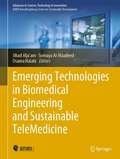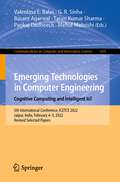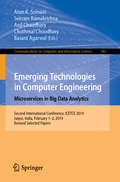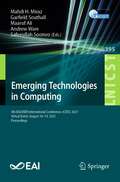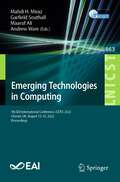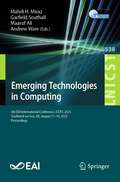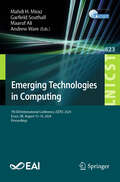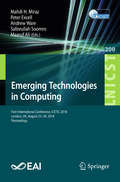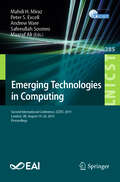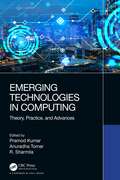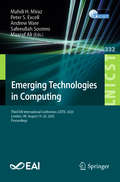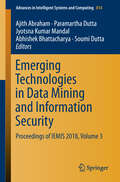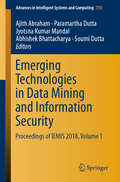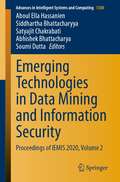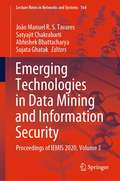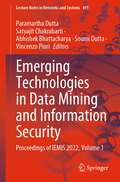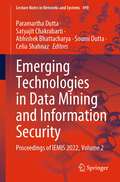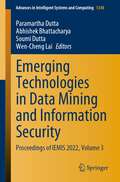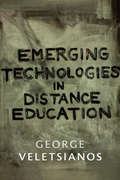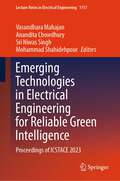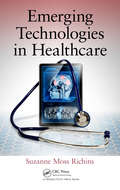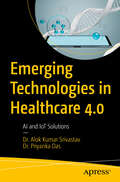- Table View
- List View
Emerging Technologies in Biomedical Engineering and Sustainable TeleMedicine (Advances in Science, Technology & Innovation)
by Somaya Al-Maadeed Jihad Alja’am Osama HalabiThis book presents the most recent research and applications in Biomedical Engineering, electronic health and TeleMedicine. Top-scholars and research leaders in the field contributed to the book. It covers a broad range of applications including smart platforms like DietHub which connects patients with doctors online. The book highlights the advantages of Telemedicine to improve the healthcare services and how it can contribute to the homogenization of medicine without any geographical barriers. Telemedicine transforms local hospitals, with limited services, into a node of an integrated network. In this manner, these nodes start to play an important role in preventive medicine and in high-level management of chronic diseases. The authors also discuss the challenges related to “health informatics” and in “e-health management”. The topics of the book include: synchronous and asynchronous telemedicine with deep discussions on e-health applications, virtual medical assistance, real-time virtual visits, digital telepathology, home health monitoring, and medication adherence, wearable sensors, tele-monitoring hubs and sensors, Internet of Things, augmented and virtual reality as well as e-learning technologies. The scope of the book is quite unique particularly in terms of the application domains that it targets. It is a unique hub for the dissemination of state of the art research in the telemedicine field and healthcare ecosystems. The book is a reference for graduate students, doctors, and researchers to discover the most recent findings, and hence, it achieves breakthroughs and pushes the boundaries in the related fields.
Emerging Technologies in Business: Innovation Strategies for Competitive Advantage
by Andrei O. J. Kwok Pei-Lee TehThis book is a collection of studies that explores the adoption, applications, and implications of emerging technologies in business. Given that emerging technologies have the potential to significantly disrupt and transform existing business models, the premise is to demonstrate how theories are translated into practice. Readers will gain insights into operating processes and business models, the diffusion of innovation in business and industry, and how humans interact with emerging technologies.
Emerging Technologies in Computer Engineering: 5th International Conference, ICETCE 2022, Jaipur, India, February 4–5, 2022, Revised Selected Papers (Communications in Computer and Information Science #1591)
by Basant Agarwal Valentina E. Balas G. R. Sinha Tarun Kumar Sharma Pankaj Dadheech Mehul MahrishiThis book constitutes the refereed proceedings of the 5th International Conference on Emerging Technologies in Computer Engineering, ICETCE 2021, held in Jaipur, India, in February 2022.The 40 revised full papers along with 20 short papers presented were carefully reviewed and selected from 235 submissions. The papers are organized according to the following topical headings: cognitive computing; Internet of Things (IoT); machine learning and applications; soft computing; data science and big data analytics; blockchain and cyber security.
Emerging Technologies in Computer Engineering: Second International Conference, ICETCE 2019, Jaipur, India, February 1–2, 2019, Revised Selected Papers (Communications in Computer and Information Science #985)
by Seeram Ramakrishna Basant Agarwal Arun K. Somani Anil Chaudhary Chothmal ChoudharyThis book constitutes the refereed proceedings of the Second International Conference on Emerging Technologies in Computer Engineering: Microservices in Big Data Analytics, ICETCE 2019, held in Jaipur, India, in February 2019. The 28 revised full papers along with 1 short paper presented were carefully reviewed and selected from 253 submissions. ICETCE conference aims to showcase advanced technologies, techniques, innovations and equipments in computer engineering. It provides a platform for researchers, scholars, experts, technicians, government officials and industry personnel from all over the world to discuss and share their valuable ideas and experiences.
Emerging Technologies in Computing: 4th EAI/IAER International Conference, iCETiC 2021, Virtual Event, August 18–19, 2021, Proceedings (Lecture Notes of the Institute for Computer Sciences, Social Informatics and Telecommunications Engineering #395)
by Andrew Ware Mahdi H. Miraz Safeeullah Soomro Maaruf Ali Garfield SouthallThis book constitutes the refereed conference proceedings of the 4th International Conference on Emerging Technologies in Computing, iCEtiC 2021, held in August 2021. Due to VOVID-19 pandemic the conference was helt virtually. The 15 revised full papers were reviewed and selected from 44 submissions and are organized in topical sections covering Information and Network Security; Cloud, IoT and Distributed Computing; AI, Expert Systems and Big Data Analytics
Emerging Technologies in Computing: 5th EAI International Conference, iCETiC 2022, Chester, UK, August 15-16, 2022, Proceedings (Lecture Notes of the Institute for Computer Sciences, Social Informatics and Telecommunications Engineering #463)
by Andrew Ware Mahdi H. Miraz Maaruf Ali Garfield SouthallThis book constitutes the refereed conference proceedings of the 5th EAI International Conference on Emerging Technologies in Computing, iCETiC 2022, held in Chester, UK, August 15-16, 2022. The 16 full papers included in this book were carefully reviewed and selected from 54 submissions. They were organized in topical sections as follows: Cloud, IoT and Distributed Computing; and AI, Expert Systems and Big Data Analytics.
Emerging Technologies in Computing: 6th EAI International Conference, iCETiC 2023, Southend-on-Sea, UK, August 17-18, 2023, Proceedings (Lecture Notes of the Institute for Computer Sciences, Social Informatics and Telecommunications Engineering #538)
by Andrew Ware Mahdi H. Miraz Maaruf Ali Garfield SouthallThis book constitutes the refereed conference proceedings of the 6th International Conference on Emerging Technologies in Computing, iCETiC 2023, held at Southend-on-Sea, UK, in August 2023.The 15 revised full papers were reviewed and selected from 41 submissions and are organised in topical sections covering AI, expert systems and big data analytics; information and network security; cloud, IoT and distributed computing.
Emerging Technologies in Computing: 7th EAI International Conference, iCETiC 2024, Essex, UK, August 15–16, 2024, Proceedings (Lecture Notes of the Institute for Computer Sciences, Social Informatics and Telecommunications Engineering #623)
by Andrew Ware Mahdi H. Miraz Maaruf Ali Garfield SouthallThis book LNICST 623 constitutes the refereed conference proceedings of the 7th International Conference on Emerging Technologies in Computing, iCETiC 2024, held in Essex, UK, during August 15–16, 2024. The 17 full papers were carefully reviewed and selected from 58 submissions. The proceedings focus on topics such as 1) AI, Expert Systems and Big Data Analytics 2) Cloud, IoT and Distributed Computing
Emerging Technologies in Computing: First International Conference, iCETiC 2018, London, UK, August 23–24, 2018, Proceedings (Lecture Notes of the Institute for Computer Sciences, Social Informatics and Telecommunications Engineering #200)
by Andrew Ware Mahdi H. Miraz Peter Excell Safeeullah Soomro Maaruf AliThis book constitutes the refereed conference proceedings of the First International Conference on Emerging Technologies in Computing, iCEtiC 2018, held in London, UK, in August 2018. The 26 revised full papers were reviewed and selected from more than 59 submissions and are organized in topical sections covering Cloud, IoT and distributed computing, software engineering, communications engineering and vehicular technology, AI, expert systems and big data analytics, Web information systems and applications, security, database system, economics and business engineering, mLearning and eLearning.
Emerging Technologies in Computing: Second International Conference, iCETiC 2019, London, UK, August 19–20, 2019, Proceedings (Lecture Notes of the Institute for Computer Sciences, Social Informatics and Telecommunications Engineering #285)
by Andrew Ware Mahdi H. Miraz Safeeullah Soomro Maaruf Ali Peter S. ExcellThis book constitutes the refereed conference proceedings of the Second International Conference on Emerging Technologies in Computing, iCEtiC 2019, held in London, UK, in August 2019. The 24 revised full papers were reviewed and selected from 52 submissions and are organized in topical sections covering blockchain and cloud computing, security, wireless sensor networks and Internet of Things, (IoT), FinTech, AI, big data and data analytics.
Emerging Technologies in Computing: Theory, Practice, and Advances
by Pramod KumarEmerging Technologies in Computing: Theory, Practice, and Advances reviews the past, current, and future needs of technologies in the computer science field while it also discusses the emerging importance of appropriate practices, advances, and their impact. It outlines emerging technologies and their principles, challenges, and applications as well as issues involved in the digital age. With the rapid development of technologies, it becomes increasingly important for us to remain up to date on new and emerging technologies. It draws a clear illustration for all those who have a strong interest in emerging computing technologies and their impacts on society. Features: Includes high-quality research work by academicians and industrial experts in the field of computing Offers case studies related to Artificial Intelligence, Blockchain, Internet of Things, Multimedia Big Data, Blockchain, Augmented Reality, Data Science, Robotics, Cybersecurity, 3D Printing, Voice Assistants and Chatbots, and Future Communication Networks Serves as a valuable reference guide for anyone seeking knowledge about where future computing is heading
Emerging Technologies in Computing: Third EAI International Conference, iCETiC 2020, London, UK, August 19–20, 2020, Proceedings (Lecture Notes of the Institute for Computer Sciences, Social Informatics and Telecommunications Engineering #332)
by Andrew Ware Mahdi H. Miraz Safeeullah Soomro Maaruf Ali Peter S. ExcellThis book constitutes the refereed conference proceedings of the Third International Conference on Emerging Technologies in Computing, iCEtiC 2020, held in London, UK, in August 2020. Due to VOVID-19 pandemic the conference was helt virtually.The 25 revised full papers were reviewed and selected from 65 submissions and are organized in topical sections covering blockchain and cloud computing; security, wireless sensor networks and IoT; AI, big data and data analytics; emerging technologies in engineering, education and sustainable development.
Emerging Technologies in Data Mining and Information Security: Proceedings Of Iemis 2018, Volume 3 (Advances In Intelligent Systems and Computing #814)
by Ajith Abraham Paramartha Dutta Jyotsna Kumar Mandal Abhishek Bhattacharya Soumi DuttaThe book features research papers presented at the International Conference on Emerging Technologies in Data Mining and Information Security (IEMIS 2018) held at the University of Engineering & Management, Kolkata, India, on February 23–25, 2018. It comprises high-quality research by academics and industrial experts in the field of computing and communication, including full-length papers, research-in-progress papers, case studies related to all the areas of data mining, machine learning, IoT and information security.
Emerging Technologies in Data Mining and Information Security: Proceedings Of Iemis 2018, Volume 3 (Advances In Intelligent Systems and Computing #814)
by Ajith Abraham Paramartha Dutta Jyotsna Kumar Mandal Abhishek Bhattacharya Soumi DuttaThe book features research papers presented at the International Conference on Emerging Technologies in Data Mining and Information Security (IEMIS 2018) held at the University of Engineering & Management, Kolkata, India, on February 23–25, 2018. It comprises high-quality research by academics and industrial experts in the field of computing and communication, including full-length papers, research-in-progress papers, case studies related to all the areas of data mining, machine learning, IoT and information security.
Emerging Technologies in Data Mining and Information Security: Proceedings Of Iemis 2018, Volume 3 (Advances In Intelligent Systems and Computing #814)
by Ajith Abraham Paramartha Dutta Jyotsna Kumar Mandal Abhishek Bhattacharya Soumi DuttaThis book features research papers presented at the International Conference on Emerging Technologies in Data Mining and Information Security (IEMIS 2018) held at the University of Engineering & Management, Kolkata, India, on February 23–25, 2018. It comprises high-quality research work by academicians and industrial experts in the field of computing and communication, including full-length papers, research-in-progress papers, and case studies related to all the areas of data mining, machine learning, Internet of Things (IoT) and information security.
Emerging Technologies in Data Mining and Information Security: Proceedings of IEMIS 2020, Volume 1 (Advances in Intelligent Systems and Computing #1286)
by Siddhartha Bhattacharyya Aboul Ella Hassanien Abhishek Bhattacharya Soumi Dutta Satyajit ChakrabatiThis book features research papers presented at the International Conference on Emerging Technologies in Data Mining and Information Security (IEMIS 2020) held at the University of Engineering & Management, Kolkata, India, during July 2020. The book is organized in three volumes and includes high-quality research work by academicians and industrial experts in the field of computing and communication, including full-length papers, research-in-progress papers and case studies related to all the areas of data mining, machine learning, Internet of things (IoT) and information security.
Emerging Technologies in Data Mining and Information Security: Proceedings of IEMIS 2020, Volume 2 (Advances in Intelligent Systems and Computing #1300)
by Siddhartha Bhattacharyya Aboul Ella Hassanien Abhishek Bhattacharya Soumi Dutta Satyajit ChakrabatiThis book features research papers presented at the International Conference on Emerging Technologies in Data Mining and Information Security (IEMIS 2020) held at the University of Engineering & Management, Kolkata, India, during July 2020. The book is organized in three volumes and includes high-quality research work by academicians and industrial experts in the field of computing and communication, including full-length papers, research-in-progress papers and case studies related to all the areas of data mining, machine learning, Internet of things (IoT) and information security.
Emerging Technologies in Data Mining and Information Security: Proceedings of IEMIS 2020, Volume 3 (Lecture Notes in Networks and Systems #164)
by João Manuel R. S. Tavares Satyajit Chakrabarti Abhishek Bhattacharya Sujata GhatakThis book features research papers presented at the International Conference on Emerging Technologies in Data Mining and Information Security (IEMIS 2020) held at the University of Engineering & Management, Kolkata, India, during July 2020. The book is organized in three volumes and includes high-quality research work by academicians and industrial experts in the field of computing and communication, including full-length papers, research-in-progress papers, and case studies related to all the areas of data mining, machine learning, Internet of things (IoT), and information security.
Emerging Technologies in Data Mining and Information Security: Proceedings of IEMIS 2022, Volume 1 (Lecture Notes in Networks and Systems #491)
by Vincenzo Piuri Paramartha Dutta Satyajit Chakrabarti Abhishek Bhattacharya Soumi DuttaThis book features research papers presented at the International Conference on Emerging Technologies in Data Mining and Information Security (IEMIS 2022) held at Institute of Engineering & Management, Kolkata, India, during February 23–25, 2022. The book is organized in three volumes and includes high-quality research work by academicians and industrial experts in the field of computing and communication, including full-length papers, research-in-progress papers and case studies related to all the areas of data mining, machine learning, Internet of Things (IoT) and information security.
Emerging Technologies in Data Mining and Information Security: Proceedings of IEMIS 2022, Volume 2 (Lecture Notes in Networks and Systems #490)
by Paramartha Dutta Satyajit Chakrabarti Abhishek Bhattacharya Soumi Dutta Celia ShahnazThis book features research papers presented at the International Conference on Emerging Technologies in Data Mining and Information Security (IEMIS 2022) held at Institute of Engineering & Management, Kolkata, India, during 23–25 February 2022. The book is organized in three volumes and includes high-quality research work by academicians and industrial experts in the field of computing and communication, including full-length papers, research-in-progress papers, and case studies related to all the areas of data mining, machine learning, Internet of Things (IoT) and information security.
Emerging Technologies in Data Mining and Information Security: Proceedings of IEMIS 2022, Volume 3 (Advances in Intelligent Systems and Computing #1348)
by Paramartha Dutta Abhishek Bhattacharya Soumi Dutta Wen-Cheng LaiThis book features research papers presented at the International Conference on Emerging Technologies in Data Mining and Information Security (IEMIS 2022) held at Institute of Engineering & Management, Kolkata, India, during February 23–25, 2022. The book is organized in three volumes and includes high-quality research work by academicians and industrial experts in the field of computing and communication, including full-length papers, research-in-progress papers, and case studies related to all the areas of data mining, machine learning, Internet of Things (IoT), and information security.
Emerging Technologies in Distance Education
by George VeletsianosA one-stop knowledge resource, Emerging Technologies in Distance Education showcases the international work of research scholars and innovative distance education practitioners who use emerging interactive technologies for teaching and learning at a distance. This widely anticipated book harnesses the dispersed knowledge of international experts who highlight pedagogical, organizational, cultural, social, and economic factors that influence the adoption and integration of emerging technologies in distance education.
Emerging Technologies in Electrical Engineering for Reliable Green Intelligence: Proceedings of ICSTACE 2023 (Lecture Notes in Electrical Engineering #1117)
by Mohammad Shahidehpour Sri Niwas Singh Vasundhara Mahajan Anandita ChowdhuryThe book includes peer-reviewed papers from the International Conference on Sustainable Technology and Advanced Computing in Electrical Engineering (ICSTACE 2023). The main focus of the book is to provide the global perspective of sustainable research related to computer advancement in electrical engineering. This involves the areas related to sustainable development. This volume covers artificial intelligence, machine learning, the Internet of Things (IoT), cloud computing, big data analysis, blockchain, cyber security of the smart grid, etc. The book focuses on the areas related to sustainable development and includes research works from academicians and industry experts. The book discusses new challenges and provides solutions at the interface of technology, information, complex systems, and future research directions.
Emerging Technologies in Healthcare
by Suzanne Moss RichinsRecent changes in healthcare delivery as mandated by the Patient Protection and Affordable Care Act are forcing providers to focus on technology as a way to improve the health of the population, while engaging patients and encouraging them to take accountability for maintaining their own health. One way of doing this is through the use of mobile he
Emerging Technologies in Healthcare 4.0: AI and IoT Solutions
by Dr. Alok Srivastav Dr. Priyanka DasDelve into the evolution of healthcare technologies, exploring their impact on patient care and management. This book provides a comprehensive exploration of the industrial revolution in healthcare. In this book, you'll cover the fundamentals of Artificial Intelligence (AI) in healthcare, including an overview of AI and machine learning, applications in healthcare domains, and challenges and opportunities in AI implementation. It progresses to explore integration of AI and IoT in Healthcare 4.0, discussing synergies, real-time data analysis, and future trends in telemedicine. The book also addresses critical aspects such as data security and privacy, focusing on regulations, standards, and strategies for ensuring data protection. Practical applications of AI and IoT in remote patient monitoring, disease diagnosis, and healthcare operations management are thoroughly examined, alongside ethical and legal considerations in Healthcare 4.0. The final chapters offer insights into emerging trends, potential challenges, and recommendations for successfully adopting AI and IoT in healthcare. Readers will gain a comprehensive understanding of how AI and IoT are revolutionizing healthcare, from enhancing patient outcomes and operational efficiencies to navigating the ethical and legal landscapes of data privacy. This book equips healthcare professionals, policymakers, and technology enthusiasts with knowledge to navigate and leverage transformative potential of Healthcare 4.0 technologies effectively. You Will Explore the integration of AI with IoT technologies in Healthcare 4.0 Gain insights into the ethical and legal considerations surrounding AI and IoT implementations in healthcare Learn about emerging trends and future perspectives in Healthcare 4.0, including the potential challenges and recommendations Discover case studies and practical examples illustrating the transformative impact of AI and IoT on patient care Who Is This Book For Readers with foundational understanding of healthcare systems and technologies will benefit most from this book. Specifically, a basic knowledge of healthcare operations, medical terminology, and information technology would be advantageous. Familiarity with concepts related to AI and IoT in healthcare, though not mandatory, would also enhance comprehension of the advanced topics covered in the book.
